As the chief marketeer for the Michigan Bed and Breakfast Association, I love learning about the history of our member inns. Seeing our bed and breakfasts’ different architectural styles throughout Michigan is intriguing. Buildings with historical significance, stories of the past, and caring innkeepers- this is what makes our “Best Historic Inns in Michigan” so special.
11 Best Historic Inns in Michigan
Highlighted below, in no particular order, are some member inns that are historic properties. I’ve included some fun tidbits of history and added current information about each property and the features that set them apart. These historic gems fill up quickly, so book your stay today and learn about some important Michigan history.

1. Antiquities Wellington Inn-Traverse City
Northwest Michigan
This Traverse City “show stopper” was built in 1905! The neo-classic mansion is now called the Antiquities’ Wellington Inn and has been beautifully restored to its original grandeur. Guests are magically transported back to an era of quiet and gracious hospitality.
This majestic home was built by one of Traverse City’s lumber barons, and the history of this family is not your typical lumber baron story and is highlighted below.
In 1892, William Cary Hull came to Traverse City to join his father in the family business; the company produced small, paper-thin, wood, basket-like containers used as disposable meat trays and was called the Oval Wood Dish Company. With 325 people on the payroll, the company was the largest employer in northern Michigan.
Once settled into the family business, the younger Hull had blueprints drawn to construct their lavish home. Three years later, Hull moved his wife, Lola, and their five children into the mansion. Hull’s father built the mansion directly across the street, and another family member owned a similar residence at the corner of Wellington and State.
Not only was the Oval Wood Dish Company a major employer, but it was also a significant lumber consumer. To keep the factory humming required 15 million board feet of timber annually. During the late 1800s, Michigan was the largest timber producer in the United States. By 1915, over-harvesting led to the serious decline of the state’s lumber industry. Lack of wood forced the company in 1916 to relocate to Tupper Lake, N.Y., where lumber supplies continued to be plentiful. When the company moved, it took 50 Traverse City families with them, nearly 250 people, devastating the local economy.
Through the years, the home fell on hard times. The house stood vacant for 10 years. In the late 1920s, the four Sly brothers purchased the home and divided it into a four-family unit with four separate deeds. The home was eventually returned to a single family but remained as 4 apartments until 1999 when Barb and Hank Rishel purchased the historic home. Following an extensive restoration, they opened it in 2003 as Antiquities Wellington Inn, a landmark Bed & Breakfast and downtown jewel.
Check out this link for more information and book your stay at this extraordinary property.
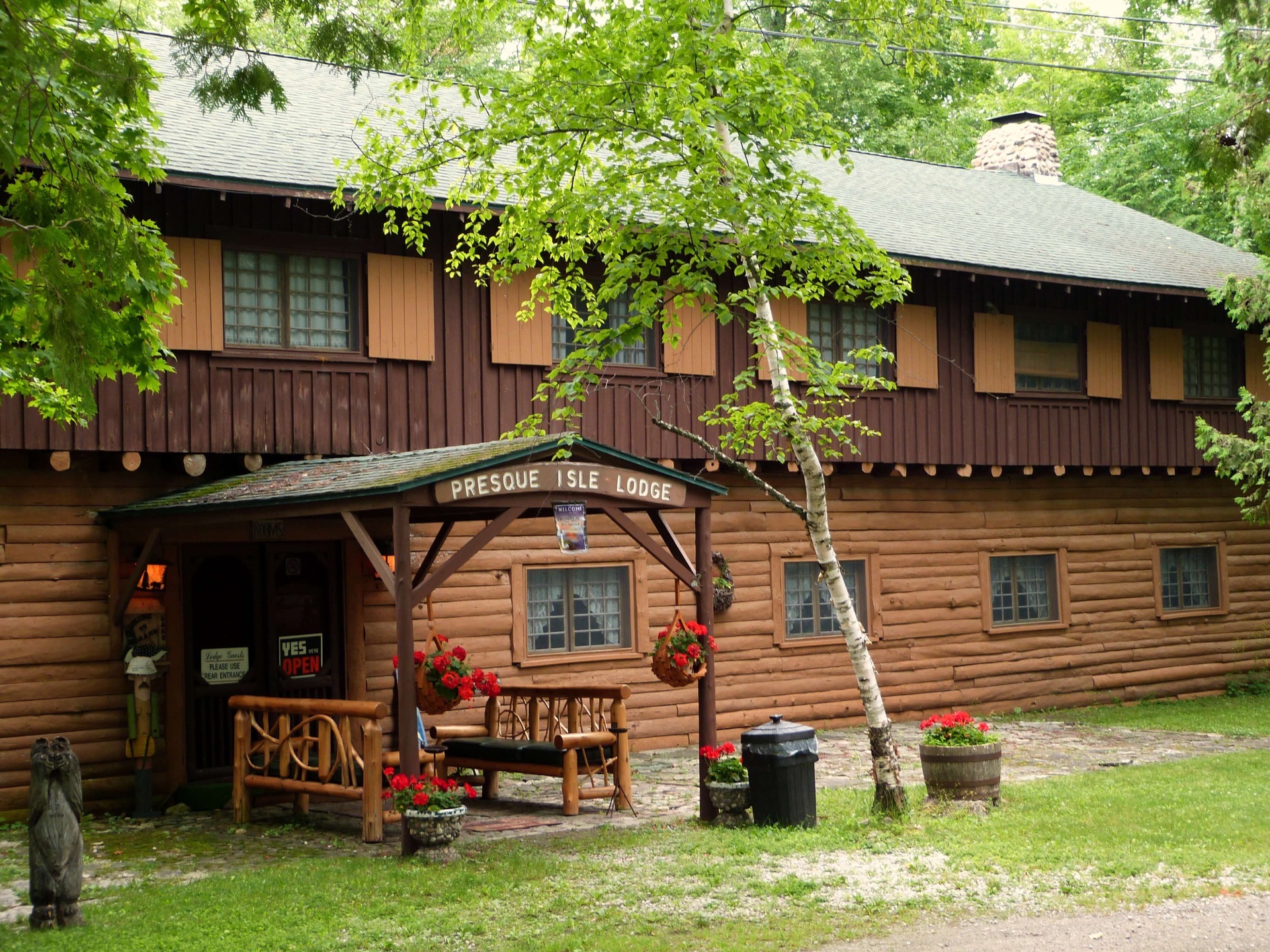
2. Presque Isle Lodge-Presque Isle
Northeast Michigan
This rustic lodge, perfectly located on the NorthEast coast of Michigan, is nestled in a scenic wooded setting and across from the gorgeous Grand Lake and islands. The lodge comes with an endearing story- the builder, Newell A. Eddy (Jr.), purchased this beautiful lakeside land with a vision to build a summer resort. Instead of building a stereotypical model, he built his resort along Colonial lines, followed by the American woodsman who constructed their homes as a fortress against frontier perils. Mr. Eddy was delighted with the results and was quoted after the lodge was completed in 1920, “I created a thing of simple beauty. Inside and out, the Lodge typified in architecture and construction, the civilization of the “Habitant” – the pioneer, the son of soil- plus, of course, every modern convenience and comfort.”
After the building was complete, the next question was what type of interior furnishing would complement the exterior. And so “Habitant Shops Inc. was created. The Lodge’s furniture collection is significant in the Arts & Crafts discipline, commonly referred to as the “Prairie School.” The first pieces of furniture of the “Habitant Shops, Inc.” were made at the Lodge. Today over 10,000 square foot Lodge contains the most extensive known remaining collection, and many of the pieces are fetching high dollars in antique stores and on eBay. Kathryn Bishop Eckert lists the Presque Isle Lodge in the Society of Architectural Historian’s Buildings of Michigan.

This summer lodge is open from May to September. Guests enjoy lovely hospitality, simple yet comfortable furnishing, delicious homemade food, and close access to the gorgeous Grand Lake with its 14 islands. Here you will find water sports galore and everything to make your family vacation a highlight of your summer.
The Lodge is ideal for a reunion or family gathering, with plenty of indoor and outdoor places to gather.
For more details and to book a stay, check out this link.

3. Frederick K. Stearns- Detroit
Southeast Michigan
Looking for an urban getaway where you can bask in luxury and learn about an influential family’s history? This Detroit icon was built in 1902 for Frederick K Stearns, who, along with his father, built a successful pharmaceutical business in Detroit. William Stratton designed the elaborate home with a rich architectural palette of refined medieval design and structure. In 1985, it was listed on the National Register of Historic Places. The historic landmark recently underwent an elaborate four-year renovation and boasts a trendy West Village neighborhood, offering easy access to all the culture and foodie experiences in the beloved motor city.
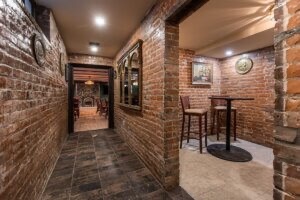
A getaway to Stearn’s mansion can include an artful signature cocktail in the basement in the original Speak-Easy Pub and Lady’s Lounge. Capture the mansion’s original splendor while basking in the comfort of your elegant suite. From glimmering chandeliers and the beauty of the grand staircase and ballroom to the millwork in the foyer and the original Moravian hearth oven to the painted glasswork on the leaded glass European windows and the tasteful art and beautiful antiques that adorn the inn, you will take a journey back in time.
Current owner Rachel Mitchell loves sharing the history of their treasured property. She was recently quoted about the area and inn, “Detroit has many historic homes and grand architecture. Detroit is the city of Rome for Europe as it was for this country back in the day for its economic and cultural significance. It has gone through hard times, but what made the city great is still here; that is the Detroit spirit that was embodied so well by Frederick K. Stearns. His father’s entrepreneurial spirit brought the family from Buffalo, New York, to Detroit. He was the president of Frederick Stearns & Company, a pharmaceutical manufacturing business, from 1887 to 1921. He was the organizer of the Detroit Orchestral Association, which later became the Detroit Symphony Orchestra, a trustee of the Detroit Museum of Art, and the owner of the Detroit Wolverines baseball team in the National League from 1885 to 1888. In Ann Arbor, a collection of more than 2500 musical instruments, the basis of which is from the Stream family, is kept at the University of Michigan’s School of Music. He was a world traveler and a learner. The basis of the Detroit Institute of Art’s Egyptian collection was originally their private collection.”
Book your stay today and relax in the old-fashioned SpeakEasy Bar with a hand-crafted cocktail. You will be transported back to a bygone era and feel like a very successful Detroiter.
For more information, check out this link.
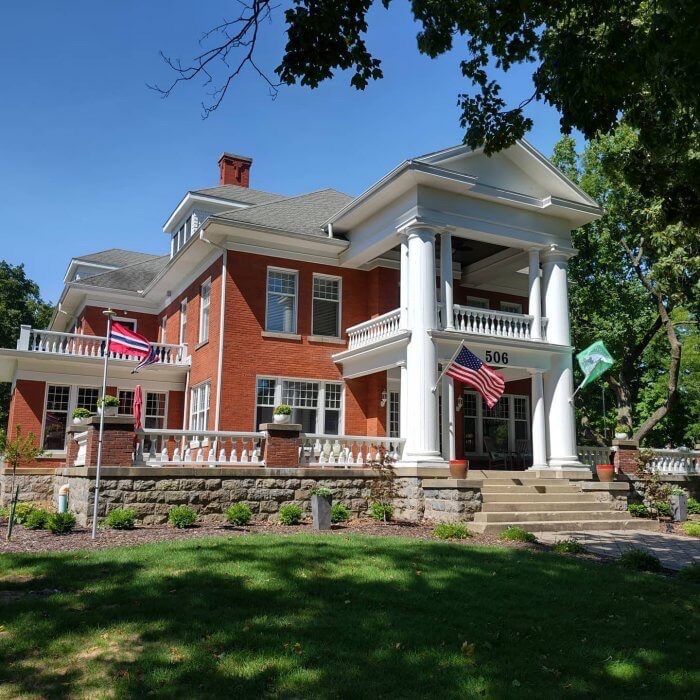
4. Nordic Pineapple, St.Johns
Southeast, Michigan
Step back in time at The Nordic Pineapple; here, you’ll find history around every corner. This local icon has been home to many families and now hosts travelers near and far.
Civil War General Oliver Spaulding, a lawyer, built the core of the home in 1861 as a gift for his wife. He started building the house, then went off to fight in the Civil War, where he became brevetted brigadier general in the 23rd Michigan Infantry.
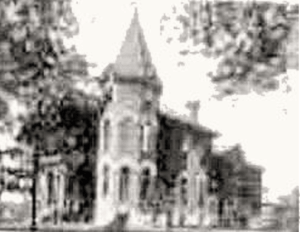
After the war, he returned and finished the house, became Michigan Secretary of State, and later a special agent of the United States Treasury Department. He served until 1880, following his election to the U.S. Congress. In 1885, he was again appointed special agent of the U.S. Treasury Department and served as Assistant Secretary of the U.S. Treasury Department. This original architecture looked much different from today and was smaller and more Victorian in style, with a turret on the front.
In 1911, Clarence Babcock purchased the property and orchestrated a massive renovation, adding several rooms and large white Colonial-style pillars on either side of the front door, complete with a third-floor ballroom. Several owners came and went when in 1950, an Encyclopedia Britannica agent, Anthony Kuntz, and his wife, Agnes, purchased the property and did additional remodeling; the house became known as the Kuntz Home. Agnes Kuntz continued to live in the home after her husband died in 1979. Tragically, the community landmark was ravaged by a fire on Nov. 1, 1992, started by a workman’s paint-removing torch. The fire destroyed the third floor, and the rest of the home sustained heavy smoke and water damage.
Mark Barber, a neighbor who lived directly across the street, a lifelong St. Johns resident, and an advocate of historic renovation, bought the home when he realized the Kuntz family would not be moving back. He started the renovation of the Colonial Revival structure, redoing the entire house, and rebuilding and restoring the original open stairway. The former third-floor ballroom became Barber’s living quarters, complete with skylights. In 1994, Oakland Place Bed and Breakfast opened. Unfortunately, Mark Barber unexpectedly passed in 2006, and the home was vacant for ten years, followed by two years as a private residence.
Innkeepers Kjersten and Greg Offenbecker took over the historic mansion in 2018 and renamed the property- the Nordic Pineapple. They, along with their two children, are providing the ultimate getaway in St. Johns that includes farm-to-table breakfasts, extraordinary hospitality, and historical property that continues to offer the ultimate in comfort and relaxation.
Check out the details of this sweet property here. Guests rave about the breakfast that can be delivered to your rooms and the wonderful laid-back hospitality.
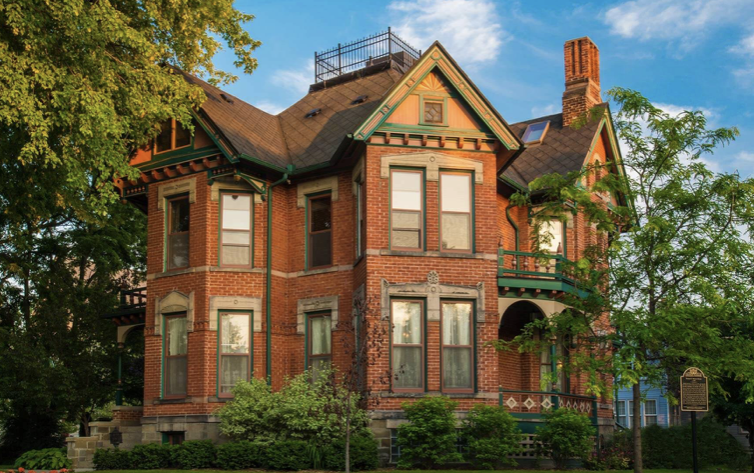
5. Historic Webster House- Bay City
Southeast Michigan
As with most historic properties, this building has an interesting story about the family it was built for. Thomas E Webster was born in New York and ran away from home to join the Union Army at 16. After an honorable discharge from the military, he entered an educational pursuit that would take him from the Delaware Literary Institute to Cornell University to the University of Michigan. In 1874, he moved to Bay City, Michigan, where he was an influential figurehead for the rest of his life. He would immediately make his mark on the city, practicing law and winning election as a Bay County probate judge in 1880.
In 1886, he commissioned the construction of his majestic Fifth Street manor with classic Queen Anne styling. Sadly, his wife, Ella Howell of Bay City, died shortly after the birth of sons Charles and Warren.
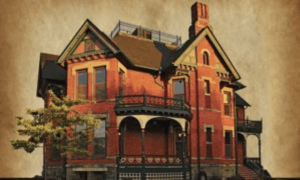
He later married Isabel Ingraham, with whom he had a daughter Amelia. A house that Webster had built for Amelia is next door. It shares the driveway with the Webster House. Throughout his adult life, Webster was committed to helping other veterans. He organized the Peninsula Military Company of Bay City, the city’s first organization for war veterans. Until he died in 1940 at age 92, he was the last living Civil War veteran in Bay City, as well as the last member of the Grand Army of the Republic, also a veterans organization. He lived in his Fifth Street Mansion until his death.
This lovely property is now called the Historic Webster House. It boasts a perfect location in the Bay City’s historic district, blocks from a quaint but bustling riverfront downtown. The beautiful three-story manor has been restored with modern features. Guests enjoy luxurious European-style sleeping, a spa, and pampering amenities. Much of its original grandeur has been preserved, making the inn a perfect romantic getaway or an elegant venue for small events. As many reviewers share, the breakfasts at the inn are both gourmet and filling and a wonderful way to start your day. Insider information- Ask about their homemade truffles! For more information and to book your stay check out this link.
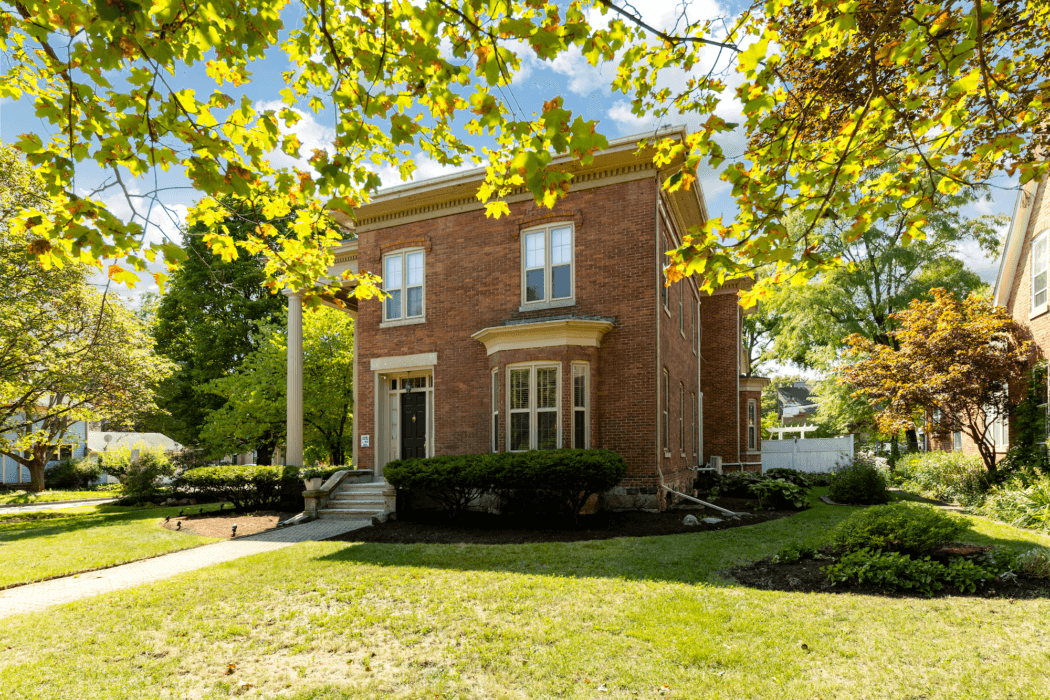
6. Newton of Ypsilanti, Ypsilanti
Southeast Michigan
Ypsilanti, named after Greek war hero Demetrius Ypsilanti, is a neighbor to Ann Arbor and a short drive from Detroit. This quaint small town has recently become a popular destination, known for its vibrant shopping, antiques, fresh art, and entertainment. The town includes three historic districts, including Downtown, the Depot Area, and West Cross. “Ypsi”, as it’s affectionately known, has a rich history, including our member inn, Newton of Ypsilanti.
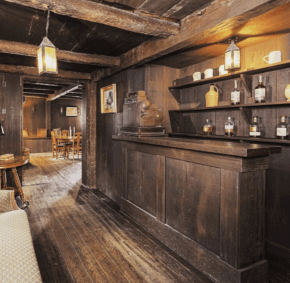
This historic property has quite a unique history, including its namesake, Charles Newton, who owned the home from 1917 to 1967. He was the lawyer and broker for Henry Ford and curated Greenfield Village’s historical buildings. After they collected one too many buildings, Ford gifted Newton with a 17th-century New England Tavern, which guests can explore on the lower level of the property.
This beautiful home was believed to have been built in 1830 by HP Glover. From 1870- 1917 the home was owned by Samual Barnard and his wife. In addition to operating a creamery in town, Barnard was VP for the Peninsular Paper Mill, a major presence in Ypsi from 1867-2001. Several prominent owners were in between, but its bed and breakfast legacy began in 1999 when it was called the Queen’s Residence B&B.
Current owners, Charles Bultman, and Allision Anastasio, purchased the property in 2021 with a vision to make this historical property a welcoming bed and breakfast and a place where the community can gather. Guests will be treated to remarkable food during their stay as Allision is a professional chef and runs a private catering and educational business called Last Bite Chef. For more information and to book your stay check out this link.

7. Jade Estate Inn, Allegan
Southwest Michigan
Always fun to hear how inns are named, and this one comes with a sweet story from Nia Green, owner of the Jade Estate Inn. “She chose the name Jade Estate Inn because she desired the name to be an expression of exquisite antiquity-meets-contemporary. Jade is an ancient gemstone that is still treasured today. It is also another name for green, the surname of the owners”
This Italianate Renaissance icon in Allegan comes with a fascinating history that comes full circle from the original carpenter who built it in 1863 to the talented local builder who recently restored it.
David Doane Davis moved to Allegan in 1835 and followed his trade of helping build many of the early structures in Allegan, including a log cabin that was his home. He prospered and was respected. Both he and his wife Hannah were very active in the community and the local First Baptist Church. D.D. Davis built this beautiful structure for their home in 1863, where they lived the rest of their lives. Upon the death of Hannah, she left her estate and home to their beloved First Baptist Church, which became a parsonage and boarding house until it was sold in 1884 to a local banker. The home was bought and sold several times and, interestingly enough, all by local bankers, as the home was prestigious and well-known.
Now comes the interesting part about the lineage of a previous owner. In 1898 the home was sold to Hiram Delano for a mere $3,000 since the previous banker became penniless and had to sell all his assets. Hiram and his wife Viola proceeded to sell the property to their son Earl Delano, and so a game of selling it back and forth from father to son began to show that their Allegan State Savings Bank was successful. When Hiram passed in 1921, the home finally retained ownership by Earl Delano.
After doing some lineage research, it was found that the Delano family are descendants of French nobility and a King of England, as well as those who came over on the Mayflower. Interesting to note that the same nobility can be connected to Ulysses S. Grant and Franklin Delano Roosevelt. After the death of Earl’s wife Mignon in 1987, the home was sold to the Ashley family, who renovated the home and began operating it as a bed and breakfast. Under other names and three prior owners, the property continued as a bed and breakfast. It had stood empty for three years when Todd Green and his wife Nia bought it out of bankruptcy in 2020.
Todd Green, who grew up in the Allegan area, was attracted to the property because its needs were a good fit for his talents as a residential builder and renovator. After determining that the mansion and carriage house are structurally in great shape, Todd enlisted his crew to revise the property to its original grandeur. So the name became The Jade Estate Inn.
Located in the heart of Allegan, MI, the Jade is an icon and show stopper. The grand mansion has been meticulously restored to its splendor, offering guests private rooms with jetted tubs, fine linens, and all the comforts of home in a luxurious setting. For more information and to book your stay check out this link.
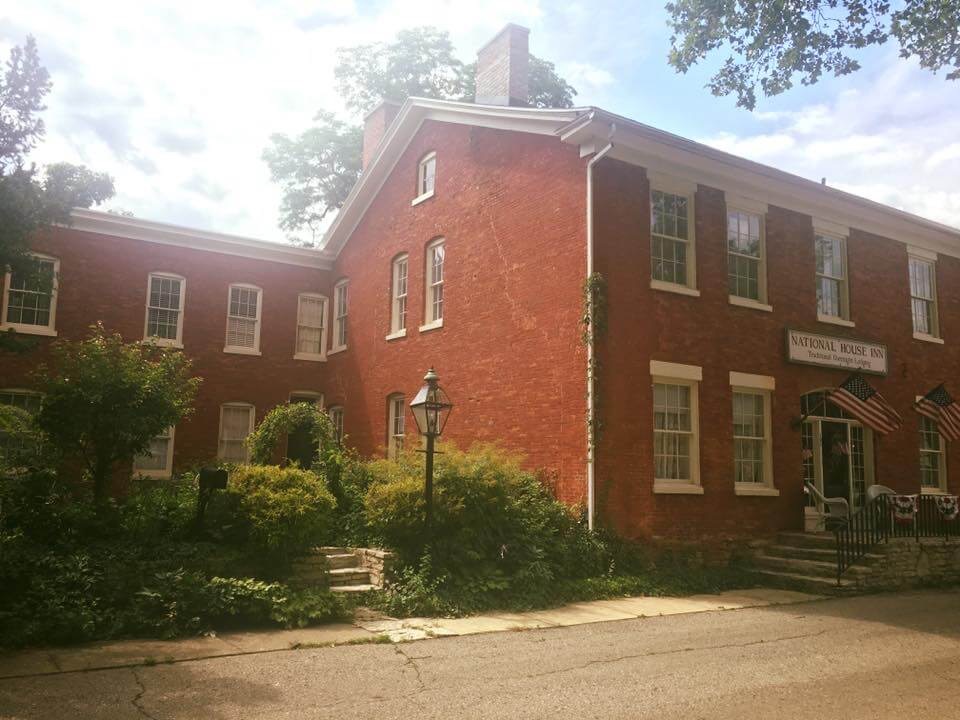
8. National House Inn, Marshall
Southwest Michigan
National House Inn is the oldest inn in Michigan and was built in 1835. The history of the National House Bed and Breakfast is beautifully written on the inn’s website and is quoted here-
“The National House Inn bed and breakfast on Marshall’s picturesque Fountain Circle is the oldest operating hotel in the State of Michigan. It has been designated as a State Historic site and listed on the National Register of Historic Places. The Inn was built in 1835 by Colonel Andrew Mann who used lumber from the Ketchum sawmill and bricks that were molded and fired on the site to construct what has endured as the oldest brick building in Calhoun County. It is believed to be a stop on the Underground Railroad.
Located two dusty days and nights by stagecoach from Detroit, the National House served as a welcome halfway haven for early travelers on the way to Chicago. With the arrival of the Michigan Central Railroad in 1844, the Inn’s fortunes became closely tied to the “Iron Horse,” and its function for the next 30 years was that of a railroad hotel.

In 1878, having gone through several owners and changes of name, the National House closed its doors as a hotel, the victim of dining cars and Pullman sleepers. At that time the building was converted to a factory devoted to the manufacture of windmills and farm wagons. An 1895 photograph of the Inn in this capacity is on display in the lobby.
In 1902 the building was purchased by Dr. Dean, a local veterinarian, who remodeled the National House into eight luxury apartments. As Dean’s Flats, the Inn passed the first three-quarters of the 20th century gradually falling into misuse and disrepair.
By 1976 it was clear that something had to be done. Help arrived in the form of dedicated restorationists Norm and Kathryn Kinney and Hal and Jacque Minick. As a bicentennial gift to the community, they proposed to restore the National House to its original purpose, that of a quaint country inn. Through hard work, imagination, and volunteer efforts from friends in Marshall, it reopened for business on Thanksgiving of 1976. Today, the current owners continuously upgrade and renovate this nationally recognized bed and breakfast inn”
If you are looking for an old-fashioned bed and breakfast-experience, call the National House Inn. Here you will find wonderful hospitality, comfortable rooms, and an inn that has been beautifully restored. For more information, check out this link.
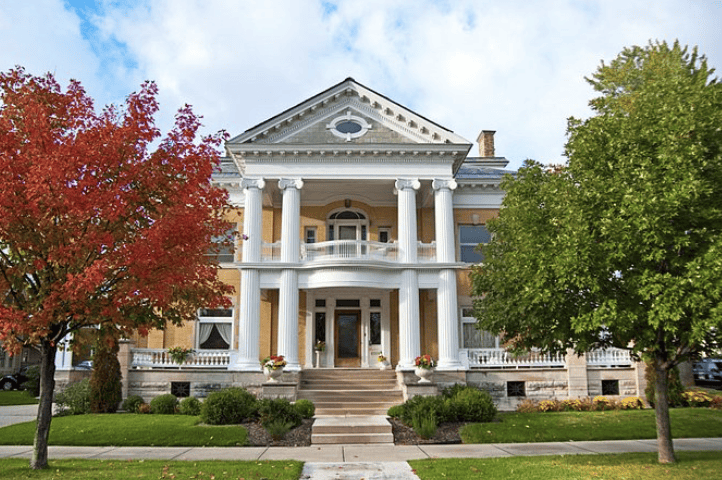
9. Cartier Mansion, Ludington
Northwest Michigan
This beauty was also built in 1905 and has similar architectural themes as the Wellington and is listed on the National Register of Historic Places. This three-story neoclassical home is primarily made from Roman pressed brick, with Bedford limestone used for trim. The interior contains several wood types, including mahogany, oak, cherry, walnut, and maple. In addition, the home is beautifully furnished with numerous period antiques.
The mansion was originally built by Warren and Kate Cartier and was considered the finest residence built in the area to reflect the classic tastes of the Cartier family. The mansion has six historic guest rooms with detailed craftsmanship, all carefully preserved from the mansion’s beginning.
When constructed, it contained many modern conveniences, that were unheard of at the time, including a steam heating system, a pulley-operated draft system to provide cooling, and chandeliers lit by both gas and electricity. An elegant sweeping staircase leads to the second floor, containing bedrooms for Warren and Kate Cartier and their children. The third floor contains a darkroom and gymnasium.
The Cartier Mansion is now a thriving upscale bed and breakfast that includes 6 of the original guest rooms in the mansion and three remodeled pet-friendly rooms in the Carriage House. For more information and to book your stay check out this link.
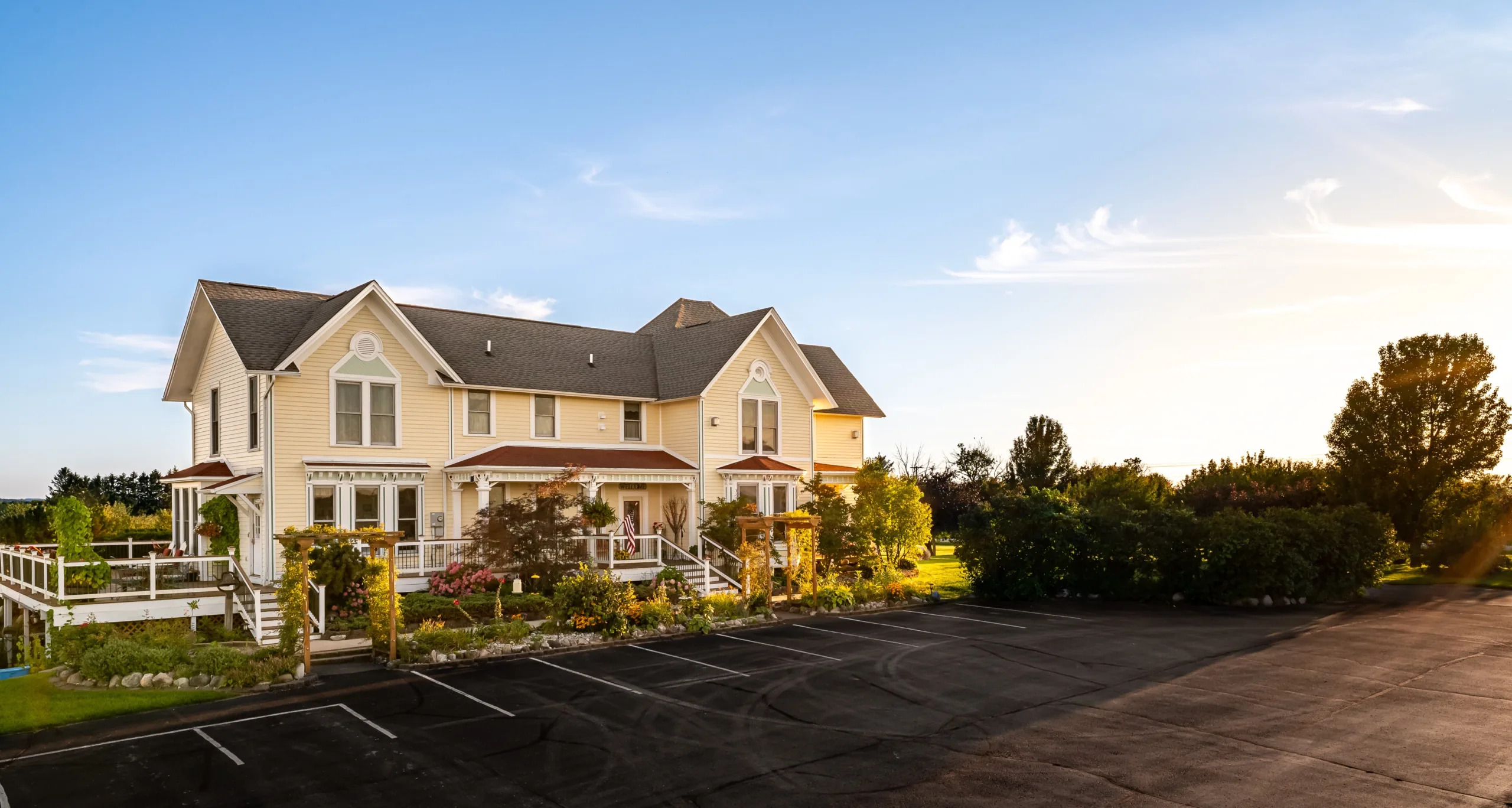
10. Country Hermitage B&B, Williamsburg
Northwest Michigan
“The Country Hermitage Bed and Breakfast continues a 130-year-old agricultural tradition on a 400-acre working cherry farm overlooking East Grand Traverse Bay. A pioneer of the region from its earliest days, John Pulcipher arrived here in 1855. He courted Mary Ann Hover a school teacher from Ohio, and in 1869 they were married. To lessen the burden of moving away from her family, John promised to build her a fine house someday. After living on the family homestead for 13 years his promise was fulfilled to her when he built a fine house in the fall of 1883.
The house was continuously inhabited until the death of Jessie Pulcipher, John’s niece in 1964. With no indoor plumbing or electricity, it sat abandoned for 35 years until restoration began in early 1999. A large addition was added to accommodate a beautiful modern kitchen. Throughout the home, the wood trim was lovingly restored to its original beauty.
The house was placed on the National Register of Historic Places in 2001 and sits splendidly among gardens and orchards providing glimpses back to former days. This Country Inn is ideally situated in a quiet country setting yet close to the popular towns of Traverse City and Elk Rapids with their many attractions. The Country Hermitage Bed and Breakfast is perfect for your romantic getaway.” As quoted from the inn’s website

An interesting and sweet story- John Pulcipher planted some climbing roses for his wife Mary Ann. She loved the roses which thrived during their lives together. When she was moved to a retirement home, her caring family moved the roses to be outside her window. Recently the original roses were moved back to the inn and are greeting guests with beautiful frangances and colors.
Today the Country Hermitage is a popular bed and breakfast. The inn is known for its country breakfasts, prepared for you by the professional chef who is also your host. The original home has been completely remodeled with upscale rooms and ensuite baths. For more information and to book your stay check out this link.
Beautiful vistas of the cherry orchards and views of the East Grand Traverse Bay beyond along with close access to Traverse City, make this an ideal location in Northern Michigan.
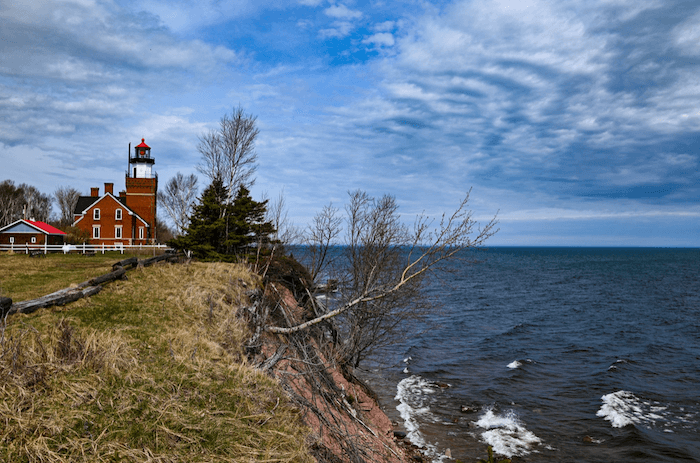
11. Big Bay Point Lighthouse, Big Bay
Last but not least is one of our association’s most unique and fun historical properties. We like to tease that, in this case, innkeeper Nick will always leave the light on for you:)
The Big Bay Point Lighthouse was built in 1896 as a two-story brick duplex building with a square, 60-foot-high square tower and outfitted with a fixed 3rd order Fresnel lens, made in France and weighing nearly 2,000 pounds. The light is located 105 feet above Lake Superior. The current light, maintained by the U.S. Coast Guard as an active aid to navigation, is a 1940s-era rotating beacon. It’s the brightest light on Lake Superior.
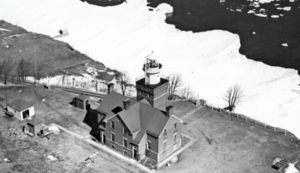
In 1986, the two-story brick building and the tower were converted into a B&B. Guests now enjoy beautiful views of Lake Superior, updated guest rooms, and wonderful hospitality.
This bed and breakfast is seasonally operated and fills up every year. Therefore, reservations are needed for this once-in-a-lifetime opportunity. For more information and to book your stay check out this link.
Come Stay at Michigan Bed and Breakfast Historical Property
Eleven options for a memorable stay in Michigan! All of our Michigan bed and breakfast inns are quality-assured and inspected for your peace of mind. We check for all the details, from pillow covers to smoke alarms. Our member inns truly are the Best of the Best!